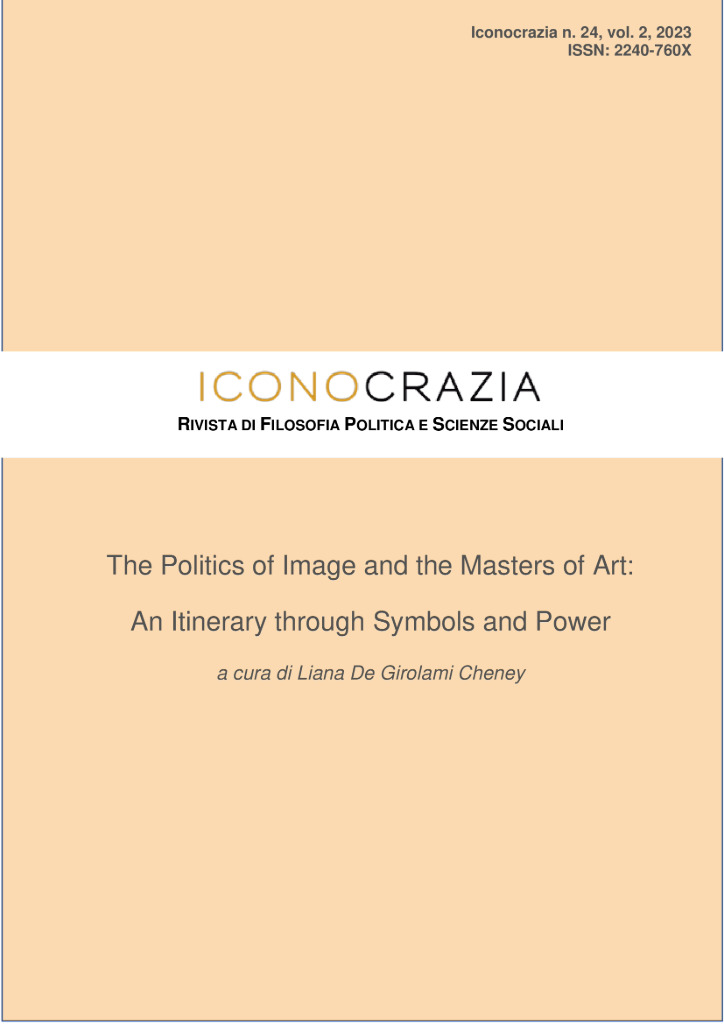Bronzino’s Christ’s Descent into Limbo: Populus, qui sedebat in tenebris, vidit lucem magnam
DOI:
https://doi.org/10.15162/2240-760X/1871Parole chiave:
Christian iconography, Borghini, Bronzino, Dante, Razzi, Vasari, Santa CroceAbstract
In 1552, the Florentine painter and poet Agnolo Bronzino (1503–1572) was commissioned to paint Christ’s Descent into Limbo for the chapel of Giovanni Zanchini in Santa Croce in Florence. The painting draws inspiration from the Scriptures (Gospel of Nicodemus), Italian poets (Boccaccio, Petrarca, and Dante Alighieri), and the theological musician Fra Silvano Razzi. In Christ’s Descent into Limbo, Bronzino skilfully integrated portraits of Old Testament figures, ancient poets, and contemporary Florentine artists. Bronzino’s painting showcases his artistic talent by blending literary and visual components well, resulting in a captivating and profound work of art. Bronzino’s painting reveals his creative talent by masterfully combining literary and visual elements, resulting in beautiful and insightful artwork.
In this essay, I aim to delve into the characters’ identities depicted in the painting by analysing its iconography and comparing it with various sacred and profane texts. The essay comprises two sections: first, an examination of the painting’s iconography, and second, an analysis of the sources from Scripture, poetry, sermons, and religious music used to identify the characters in the painting.
Riferimenti bibliografici
Apostolos-Cappadona, D. (2010). Costuming Judith in Italian Art of the Sixteenth Century. In K. R. Brine, E. Ciletti, and H. Lähnemann (eds.), The Sword of Judith: Judith Studies across the Disciplines. Cambridge, UK: Cambridge Open Book Publishers.
Baldacci, L. (1975). Lirici del Cinquecento. Milan: Longanesi.
Betti De Simonis, B. (2011). Fra’ Serafino Razzi O.P. Dottore Teologo, Marradese. Maradi-Firenze: Biblitoteca Maradi, Associazione Culturale.
Boccaccio, G. (1841). De claris muljeribus, Volgarizzamento di Maestro Donato Albanzani da Casentino. Ed. Luigi Tosti. Milan: Giovanni Silvestri.
Borghini, R. (1730). Il Riposo. Florence: Nestenus and Moucke.
Bosch, L. M. F. (2020). Mannerism, Spirituality and Cognition: The Art of Enargeia. New York: Routledge.
Calkins, A. B. (2005). “Marian Co-redemption and the Contemporary Papal Magisterium.” In Mary, Sole Cooperator in Redemption, Proceedings of the Symposium on the Mystery of Marian Co-redemption, Fatima, Portugal, May 3–7, 2005, pp. 113–169.
Cagioti, F., et al. (2022). Donatello: The Renaissance. Venice: Marsilio.
Carrara, E. (2010–2012). “Spigolature vasariane. Per un riesame delle ‘Vite’ e della loro fortuna nella Roma di primo Seicento.” Mitteilungen des Kunsthistorischen Institutes in Florenz, 54, pp. 155–184.
Cecchi, A. (1996). Bronzino. New York: Riverside Book Co.
Ciletti, E. (1990). “Judith Imagery as Catholic Orthodoxy in Counter-Reformation Italy.” In K. R. Brine, E. Ciletti, and H. Lähnemann (eds.), The Sword of Judith: Judith Studies across the Disciplines. Cambridge, UK: Cambridge Open Book Publishers.
Costamagna, P. (2010). The Drawings of Bronzino. New York: The Metropolitan Museum of Art.
Craveri, M. (ed.). (1990). Vangelo di Nicodemo, Discesa agli Inferi, I Vangeli apocrifi. Turin: Einaudi.
Alighieri, D. (1994). La Commedia secondo l’antica vulgata. Ed. G. Petrocchi. Florence: Casa Editrice le Lettere, https://www.danteonline.it/italiano/opere.asp?idope=1&idlang=OR.
De Fiores, S., and L. Gambero (eds.). (2005). Testi mariani del secondo millennio. Rome: Città Nuova Editrice.
De Girolami Cheney, L. (2000). “Giorgio Vasari's Judith: Athena or Aphrodite.” Fifteenth Century Studies Journal, 25, pp. 154–192.
Exsultet, The Exultant Praise of Easter Proclamation, https://en.wikipedia.org/wiki/Exsultet.
Falciani, C. (2010). “Della pittura sacra, ma anche di “fianchi, stomachi ecc.” In C. Falciani and A. Natali, Bronzino pittore e poeta alla corte dei Medici. Florence: Mandragora, pp. 277–295.
Gaston, R. W. (1983). “Iconography and Portraiture in Bronzino’s ‘Christ in Limbo.’” Mitteilungen des Kunsthistorischen Institutes in Florenz, 27, pp. 41–72.
Gensheimer, M. B. (2018). “Appendix 2: Freestanding Sculpture from the Baths of Caracalla.” Oxford Academic online, https://academic.oup.com/book/26054/chapter-abstract/193987538?redirectedFrom=fulltext.
Gospel of Nicodemus, Descent into Hell, https://archive.org/stream/pdfy-5lijplxCkA4qdCgY/The+Gospel+Of+Nicodemus_djvu.txt.
Limardo-Daturi, E. (2004). Représentations d’Esther entre écritures et images. Bern: Peter Lang.
Marvin, M. (1983). “Freestanding Sculptures from the Baths of Caracalla,” American Journal of Archeology, 87, no. 3 (July), pp. 374–384.
Masselli, G. (1832/38). Prefazione del compilatore delle note, in Masselli, Le opere di Giorgio Vasari, pittore e architetto aretino. Florence. David Passigli and Soci.
Matteoli, A. (1969). “La ritrattistica del Bronzino nel Limbo.” In Commentari, Rivista di critica e storia dell’arte, 20, no. 4, pp. 281–316.
Mauro, R. (1864). Expositio in librum Esther. In J.-P. Migne (ed.), Patrologiae cursus completus, series Latina. 221 vols. Paris, vol. 109.
Murphy, C. P. (2001). “Sommaia.” In Jill Berk Jiminez (ed). Dictionary of Artists’ Models. London: Fitzroy Dearborn Publishers.
Negri, G. (1722). Istoria degli scrittori fiorentini. Florence: Bernardino Pomelli.
Petrarca, F. (1958). Canzoniere, Trionfi, Rime varie, Triumphus Pudicitie. Ed. C. Muscetta and D. Ponchiroli. Turin: Einaudi.
Plaisance, M. (2008). Florence in the Time of the Medici. Toronto: CRRS Publications.
Powers, K. (2013). “Dominican Contemplazione and the Musical Lauda: Fra Serafino Razzi.” Explorations in Renaissance Culture 39, pp. 45–52.
Ead.. (2023, forthcoming). “Harmonizing the Soul: Singing Laude for the Devotional Ascent.” Iconocrazia.
Rabano, M. (1864). Expositio in librum Esther. In J.-P. Migne (ed.), Patrologiae cursus completus, series latina. Vol. 109. Paris: Imprimerie Catholique.
Razzi, S[erafino]. (1590). Sermoni predicabili per tutta la quaresima. Florence: Bartolomeo Sermartelli.
Razzi, S[ilvano]. (1614). S. Vita della Gloriosa Vergine Maria. Rome: Bartolomeo Zannetti.
Saint Anthony of Padua, I sermoni. https://www.monasterovirtuale.it/s-antonio-di-padova/s-antonio-di-padova-i-sermoni-parte-ottava.html.
Strozzi il Vecchio, G. B. (2003). Madrigali inediti. Rome: Sapienza Università di Roma (Biblioteca Italiana).
Vasari, G. (1968). Vite de’ più eccelenti pittori scultori e architettori. Ed. Paola Barocchi. Florence: Edizione Giuntina e Torrentiniana, https://vasari.sns.it/.
Varchi, B. (1568/1859). Opere di Benedetto Varchi. Trieste: Lloyd Austriaco (Biblioteca Classica Italiana).
Wallace, W. E. (2011). Michelangelo: The Artist, the Man and His Time. Cambridge, UK: Cambridge University Press.
Zeigler, T. (2013). “Altered Context: Bronzino’s Descent of Christ into Limbo.” In A. M. Galdy (ed.), Agnolo Bronzino: Medici Court Artist in Context. Cambridge, UK: Cambridge Scholars Publishing, pp. 81–107.







